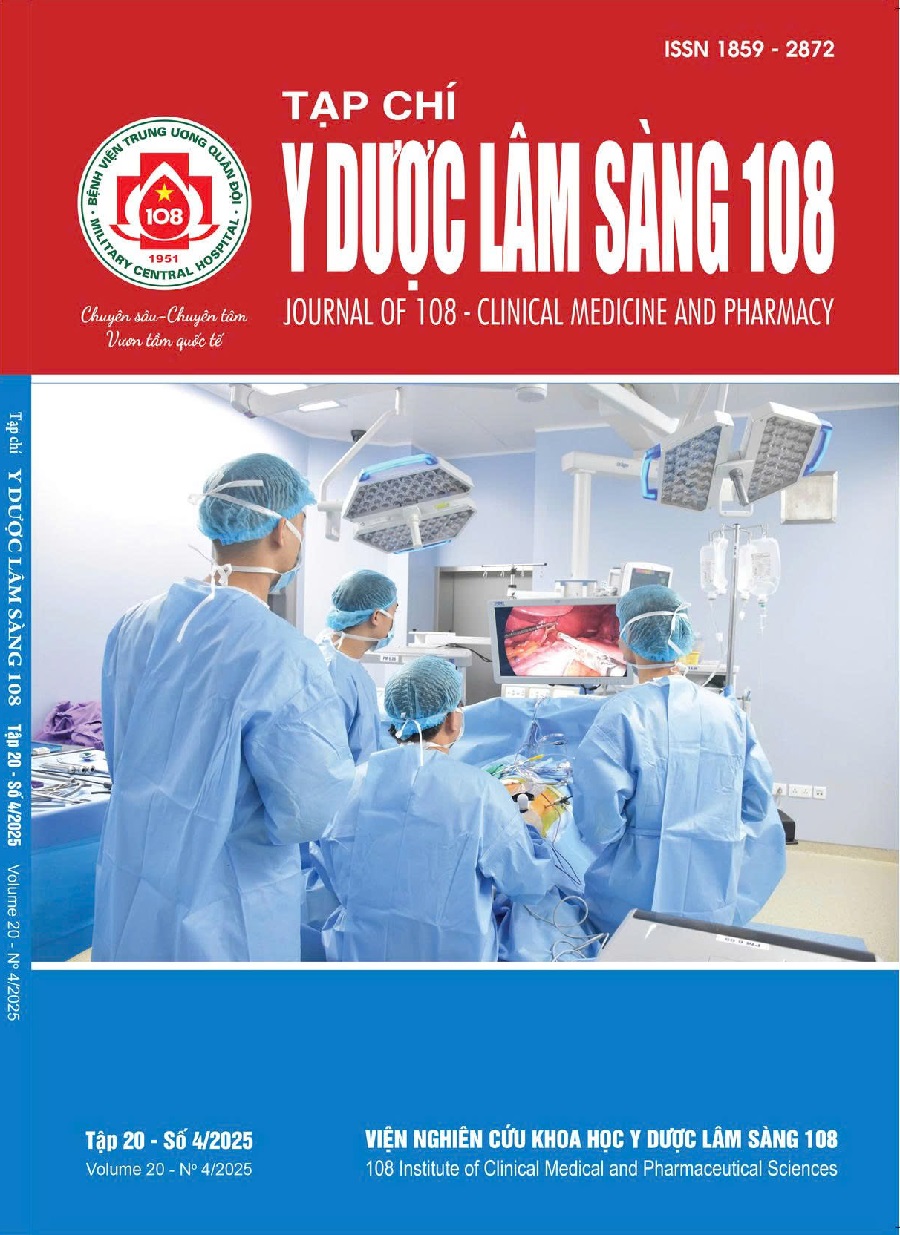A predictive model for acute kidney injury in patients with septic and septic shock
Main Article Content
Keywords
Abstract
Objective: This study aimed to establish and validate predictive models based on novel machine learning (ML) algorithms for acute kidney injury (AKI) in patients with sepsis and septic shock. Subject and method: A prospective descriptive study combined with retrospective analysis was conducted on 530 patients with sepsis or septic shock treated at 108 Military Central Hospital from 01/2020 to 01/2024 to develop a machine learning model for predicting acute kidney injury. Result: The machine learning model was built based on 8 factors: Age, gender, portal entry of infection, blood pH, HCO3-, lactate, urea, and creatinine. For predicting acute kidney injury, the model achieved a sensitivity of 82.4%, specificity of 74.4%, and AUC value = 0.84 (0.757 - 0.923). Conclusion: The machine learning-based model for predicting AKI demonstrated a good value in early prognosis of acute kidney injury in patients with sepsis and septic shock.
Article Details
References
2. Murray PT, Mehta RL, Shaw A, et al. Potential use of biomarkers in acute kidney injury: report and summary of recommendations from the 10th Acute Dialysis Quality Initiative consensus conference. Kidney Int. Mar 2014;85(3):513-21. doi:10.1038/ki.2013.374
3. Chen T, Guestrin C. XGBoost: A Scalable Tree Boosting System. 2016:785-794.
4. Singer M, Deutschman CS, Seymour CW et al (2016) The third international consensus definitions for sepsis and septic shock (sepsis-3). JAMA 315(8): 801-810. doi:10.1001/jama.2016.0287
5. Khwaja A (2012) KDIGO clinical practice guidelines for acute kidney injury. Nephron Clin Pract 120(4): 179-84. doi:10.1159/000339789
6. Xuân ĐT (2022) Nghiên cứu đặc điểm lâm sàng tổn thương thận cấp ở bệnh nhân nhiễm khuẩn nặng. Tạp chí Y học Việt Nam tập 514 - tháng 5 - số 1 - 2022.
7. Diễm HN (2019) Khảo sát tình hình tổn thương thận cấp ở bệnh nhân sốc nhiễm khuẩn tại bệnh viện đa khoa trung ương cần thơ năm 2017 - 2019. Tạp chí Y dược học cần thơ - số 19/2019. 2019;
8. Angus DC, van der Poll T (2013) Severe sepsis and septic shock. N Engl J Med 369(9): 840-851. doi:10.1056/NEJMra1208623
9. Zarbock A, Nadim MK, Pickkers P et al (2023) Sepsis-associated acute kidney injury: Consensus report of the 28th Acute Disease Quality Initiative workgroup. Nat Rev Nephrol 19(6):401-417. doi:10.1038/s41581-023-00683-3
10. Singbartl K, Kellum JA (2012) AKI in the ICU: definition, epidemiology, risk stratification, and outcomes. Kidney Int 81(9): 819-825. doi:10.1038/ki.2011.339
11. Motzkus CA, Luckmann R (2017) Does infection site matter? A systematic review of infection site mortality in sepsis. Journal of intensive care medicine 32(8): 473-479.
12. Soni J, Sinha S, Pandey R (2024) Understanding bacterial pathogenicity: A closer look at the journey of harmful microbes. Frontiers in Microbiology 15: 1370818.
13. Caraballo C, Jaimes F (2019) Organ dysfunction in sepsis: an ominous trajectory from infection to death. The Yale journal of biology and medicine 92(4): 629.
14. Vanmassenhove J, Kielstein J, Jörres A, Biesen WV (2017) Management of patients at risk of acute kidney injury. Lancet 389(10084): 2139-2151. doi:10.1016/s0140-6736(17)31329-6
15. Kellen M, Aronson S, Roizen MF, Barnard J, Thisted RA (1994) Predictive and diagnostic tests of renal failure: A review. Anesthesia & Analgesia 78(1): 134-142.
16. Schaub JA, Heung M (2019) Precision Medicine in Acute Kidney Injury: A Promising Future? Am J Respir Crit Care Med 199(7): 814-816. doi:10.1164/rccm.201810-2032ED
17. Yu X, Wu R, Ji Y, Feng Z (2023) Bibliometric and visual analysis of machine learning-based research in acute kidney injury worldwide. Front Public Health. 11: 1136939. doi:10.3389/fpubh.2023.1136939
 ISSN: 1859 - 2872
ISSN: 1859 - 2872
